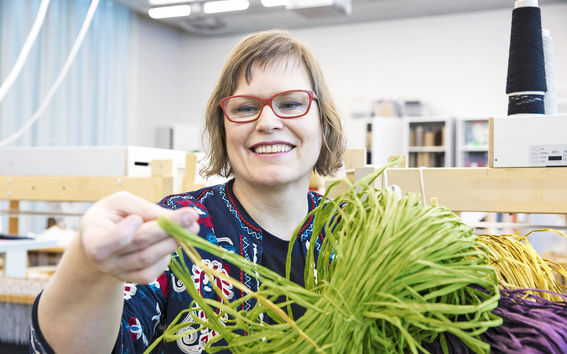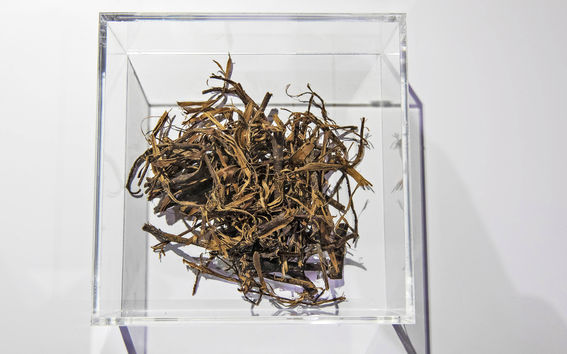Slow cycle

My grandad wore the same suit to weddings, birthday parties and funerals. My grandaunt’s wardrobe was so loosely filled that her winter dress, summer dress and party dress looked like valuable collector’s items hanging on display.
It’s a different story today, in the era of ten-euro T-shirts method. Associate Professor, Fashion Research, Kirsi Niinimäkisays a major change occurred at the turn of the millennium, when fast fashion took over the market.
“The cycle has only intensified. There used to be four collections per year, but now Zara, for example, introduces a new collection at its stores every other week.”
The volume of global clothes production has doubled in fifteen years. Some 6.4m tonnes are consumed annually in Europe alone. The service life has decreased by more than a third in the same period. An acquired item of clothing will be kept in the wardrobe for an average of three years and worn on 44 days.
After this month-and-a-half of use, it is most likely destined for incineration or a landfill.
Valuable waste
The business model of the clothing industry is linear: you start with raw material and end up with waste. Only one percent of the materials used to make clothing is utilised as raw material for new clothes.
Niinimäki notes that virgin raw materials are likely to increase in value. For example, the current world market price of cotton is low, but, as demand grows and the amount of available arable land shrinks, this is bound to change.
The clothing industry generates about a tenth of global greenhouse emissions, more than shipping and international air traffic put together. Processing discarded clothes into raw material for new textile fibre would reduce emissions substantially and prevent the industry from losing €100b worth of raw materials.
Many challenges remain on the path to a circular fashion economy.
Some of these challenges are technical, such as how to separate different fibres from each other. Especially problematic is elastane, which is added to clothes to make them more comfortable. Elastane cannot be separated from other fibres mechanically or chemically. In addition, it shortens the service life of clothing and releases colour more readily than other fibres.
“This is why black stretch jeans, for example, fade really quickly,” Kirsi Niinimäki explains.
“Our knowledge of which fibres can be recycled with each method – and which ones can’t be recycled at all – is constantly improving. This knowledge needs to get to the start of production, on top of which we should ask whether we should be making some fibres at all?”
Colours from forests and fields
The success of fibre recycling is important – but it is only the beginning. In the circular economy, chemicals need to rotate as well. One fifth of the water pollution caused by global industry is due to the dyeing of textiles and the chemicals used in the process. Some parts of China already have completely spoiled groundwater.
“If we were to recycle also the dye contained in fibres, it wouldn’t be necessary to bleach and re-dye fibres again in the next phase,” Niinimäki explains.
There are also non-toxic alternatives to dyes. Niinimäki has been researching the possibilities of vegetable dyes for a long time. Her favourite is dyer’s woad, which yields the colour blue.
“It is very Finnish and special because only it and some lichen can provide a source of natural blue dye. In a sense, we are looking back at history, as we’ve lost a lot of knowledge along the way that can be adopted back into use, combined with new technology.”
Cultivation of dye plants would provide a fresh boost to agriculture. Dyes can also be extracted from the side streams of the food and forest industries, and they can be grown with the aid of bacteria.
In addition to research knowledge and technological solutions, what’s needed is open-mindedness on the part of all parties: designers, businesses and consumers. When the point of departure is not virgin fabric but recycled material, the result can, instead of a uniform navy blue, be 20 different shades of indigo.
“Why should it all be exactly the same shade of blue anyway?” Niinimäki asks.
“We need to get away from thinking in terms of mass production. Small factories could exploit local materials and waste to manufacture more individual products – that’s the future.”
Creativity and love
When Kirsi Niinimäki graduated as a textile designer in the 80s, Finland was still a mass producer of textiles and clothes. Then the Soviet Union collapsed, and globalisation arrived.
“Now, I tell students how production progresses all the way to a finished product on the other side of the planet.”
After industry, Niinimäki made a career as an entrepreneur and then as head lecturer and training programme director at Metropolia. At Aalto, she conducts research and communicates the latest knowledge to the students.
The clothing industry has upturned completely during Niinimäki’s career and will look entirely different again thirty years from now. That’s why training emphasises the ability to learn, broad-based thinking and creative thought.
Students think about environmental loading constantly and, according to Niinimäki, almost all of them will undergo a crisis at some stage when they consider their own relationship with the industry.
“I myself try and encourage them to think on the system level, i.e. tell them that the circular economy is not about improving an individual product, it aims to change our entire way of producing and consuming. In future, we’ll design lifespans – and products that fit them – instead of designing products.”
Slowing down the materials cycle is an essential part of the change. That’s why the amount of various customisation, repair and rental services is growing. Kirsi Niinimäki believes that the structures of mass production can also be challenged.
“Fast fashion is, in fact, a really volatile business, which always involves excess production – that is then sold for a pittance or incinerated. What if everything was done according to the customer’s wishes and measurements, in a way that eliminate all waste?”
Niinimäki would counsel consumers to invest in quality and think carefully about what they buy.
“We should see our wardrobes as investments and fall in love with clothes over and over again.”

Find out more about the circular fashion economy from the book Sustainable Fashion in a Circular Economy (shop.aalto.fi) edited by Kirsi Niinimäki as well as the Ellen McArthur Foundation’s report New Textiles Economy: Re-designing Fashion’s Future (ellenmacarthurfoundation.org).
This article is published in the Aalto University Magazine issue 24 (issuu.com) April 2019.
Kirsi NiinimäkiIn future we'll design lifespans instead of products.
- Published:
- Updated:
Read more news

Broadband miniaturized spectrometer research receives QTF annual discovery award 2024
The clarity and compelling presentation of the research were one of the reasons why Doctoral Researcher Md Uddin earned the prize for the research paper, which was published in Nature Communications.
Robotics needs safe behavior patterns
Robotics and autonomous systems are developing rapidly. Algorithms that withstand disturbances and uncertainties in the system model and environment are critical for development.